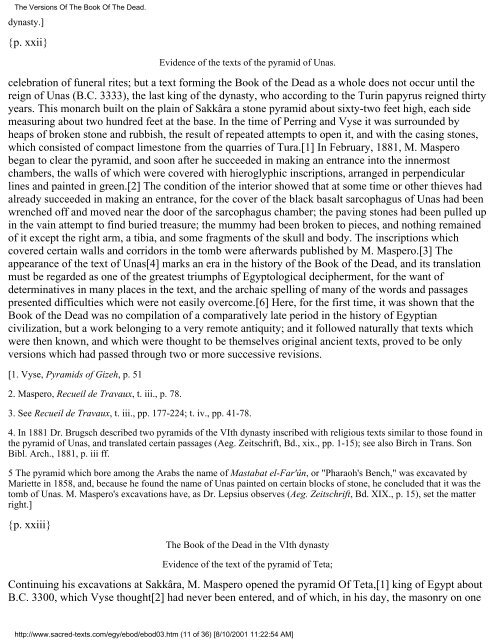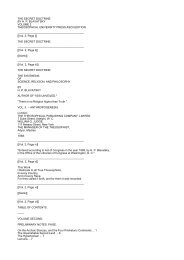You also want an ePaper? Increase the reach of your titles
YUMPU automatically turns print PDFs into web optimized ePapers that Google loves.
The Versions Of The <strong>Book</strong> Of The <strong>Dead</strong>.<br />
dynasty.]<br />
{p. xxii}<br />
Evidence <strong>of</strong> <strong>the</strong> texts <strong>of</strong> <strong>the</strong> pyramid <strong>of</strong> Unas.<br />
celebration <strong>of</strong> funeral rites; but a text forming <strong>the</strong> <strong>Book</strong> <strong>of</strong> <strong>the</strong> <strong>Dead</strong> as a whole does not occur until <strong>the</strong><br />
reign <strong>of</strong> Unas (B.C. 3333), <strong>the</strong> last king <strong>of</strong> <strong>the</strong> dynasty, who according to <strong>the</strong> Turin papyrus reigned thirty<br />
years. This monarch built on <strong>the</strong> plain <strong>of</strong> Sakkâra a stone pyramid about sixty-two feet high, each side<br />
measuring about two hundred feet at <strong>the</strong> base. In <strong>the</strong> time <strong>of</strong> Perring and Vyse it was surrounded by<br />
heaps <strong>of</strong> broken stone and rubbish, <strong>the</strong> result <strong>of</strong> repeated attempts to open it, and with <strong>the</strong> casing stones,<br />
which consisted <strong>of</strong> compact limestone from <strong>the</strong> quarries <strong>of</strong> Tura.[1] In February, 1881, M. Maspero<br />
began to clear <strong>the</strong> pyramid, and soon after he succeeded in making an entrance into <strong>the</strong> innermost<br />
chambers, <strong>the</strong> walls <strong>of</strong> which were covered with hieroglyphic inscriptions, arranged in perpendicular<br />
lines and painted in green.[2] The condition <strong>of</strong> <strong>the</strong> interior showed that at some time or o<strong>the</strong>r thieves had<br />
already succeeded in making an entrance, for <strong>the</strong> cover <strong>of</strong> <strong>the</strong> black basalt sarcophagus <strong>of</strong> Unas had been<br />
wrenched <strong>of</strong>f and moved near <strong>the</strong> door <strong>of</strong> <strong>the</strong> sarcophagus chamber; <strong>the</strong> paving stones had been pulled up<br />
in <strong>the</strong> vain attempt to find buried treasure; <strong>the</strong> mummy had been broken to pieces, and nothing remained<br />
<strong>of</strong> it except <strong>the</strong> right arm, a tibia, and some fragments <strong>of</strong> <strong>the</strong> skull and body. The inscriptions which<br />
covered certain walls and corridors in <strong>the</strong> tomb were afterwards published by M. Maspero.[3] The<br />
appearance <strong>of</strong> <strong>the</strong> text <strong>of</strong> Unas[4] marks an era in <strong>the</strong> history <strong>of</strong> <strong>the</strong> <strong>Book</strong> <strong>of</strong> <strong>the</strong> <strong>Dead</strong>, and its translation<br />
must be regarded as one <strong>of</strong> <strong>the</strong> greatest triumphs <strong>of</strong> Egyptological decipherment, for <strong>the</strong> want <strong>of</strong><br />
determinatives in many places in <strong>the</strong> text, and <strong>the</strong> archaic spelling <strong>of</strong> many <strong>of</strong> <strong>the</strong> words and passages<br />
presented difficulties which were not easily overcome.[6] Here, for <strong>the</strong> first time, it was shown that <strong>the</strong><br />
<strong>Book</strong> <strong>of</strong> <strong>the</strong> <strong>Dead</strong> was no compilation <strong>of</strong> a comparatively late period in <strong>the</strong> history <strong>of</strong> Egyptian<br />
civilization, but a work belonging to a very remote antiquity; and it followed naturally that texts which<br />
were <strong>the</strong>n known, and which were thought to be <strong>the</strong>mselves original ancient texts, proved to be only<br />
versions which had passed through two or more successive revisions.<br />
[1. Vyse, Pyramids <strong>of</strong> Gizeh, p. 51<br />
2. Maspero, Recueil de Travaux, t. iii., p. 78.<br />
3. See Recueil de Travaux, t. iii., pp. 177-224; t. iv., pp. 41-78.<br />
4. In 1881 Dr. Brugsch described two pyramids <strong>of</strong> <strong>the</strong> VIth dynasty inscribed with religious texts similar to those found in<br />
<strong>the</strong> pyramid <strong>of</strong> Unas, and translated certain passages (Aeg. Zeitschrift, Bd., xix., pp. 1-15); see also Birch in Trans. Son<br />
Bibl. Arch., 1881, p. iii ff.<br />
5 The pyramid which bore among <strong>the</strong> Arabs <strong>the</strong> name <strong>of</strong> Mastabat el-Far'ûn, or "Pharaoh's Bench," was excavated by<br />
Mariette in 1858, and, because he found <strong>the</strong> name <strong>of</strong> Unas painted on certain blocks <strong>of</strong> stone, he concluded that it was <strong>the</strong><br />
tomb <strong>of</strong> Unas. M. Maspero's excavations have, as Dr. Lepsius observes (Aeg. Zeitschrift, Bd. XIX., p. 15), set <strong>the</strong> matter<br />
right.]<br />
{p. xxiii}<br />
The <strong>Book</strong> <strong>of</strong> <strong>the</strong> <strong>Dead</strong> in <strong>the</strong> VIth dynasty<br />
Evidence <strong>of</strong> <strong>the</strong> text <strong>of</strong> <strong>the</strong> pyramid <strong>of</strong> Teta;<br />
Continuing his excavations at Sakkâra, M. Maspero opened <strong>the</strong> pyramid Of Teta,[1] king <strong>of</strong> Egypt about<br />
B.C. 3300, which Vyse thought[2] had never been entered, and <strong>of</strong> which, in his day, <strong>the</strong> masonry on one<br />
http://www.sacred-texts.com/egy/ebod/ebod03.htm (11 <strong>of</strong> 36) [8/10/2001 11:22:54 AM]

















